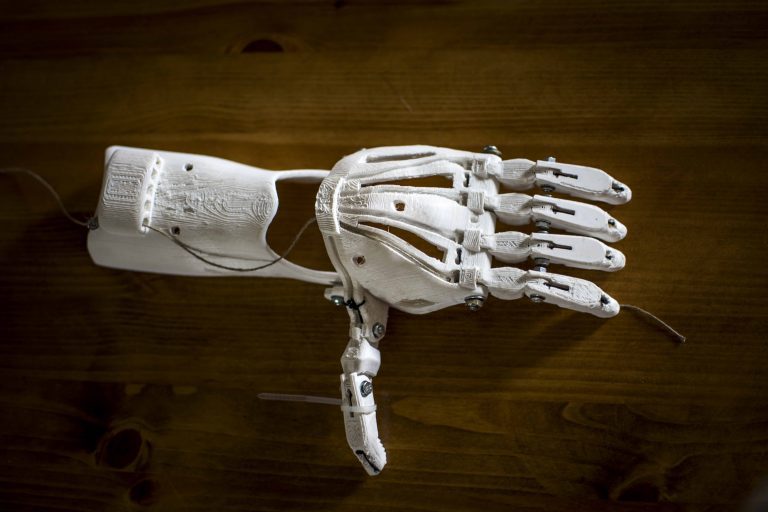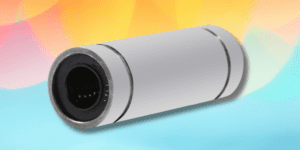Spis treści:
- 1 3D printing older than you think
- 2 The 1980s. Birth of 3D printing technology – SLA
- 3 Second half of the 1980s 3D printing FDM/FFF and SLS
- 4 Lata dziewięćdziesiąte. Nowi producenci drukarek 3D i narzędzia CAD
- 5 The 2000s: 3D printing hits the red carpet
- 6 The first decade of the 21st century. Innovations and hopes. 3D printing arrives in households
- 7 Modernity of the last decade. 3D printing gallops forward
- 8 3D Printing – Timeline
We do not just live by the technical sciences. At Botland, we love history and know how much can be learned from it. So today, let’s take a look at where the field of 3D printing came from and why it has consumed us utterly for so many years.
3D printing older than you think
To start with, a quick overview of the trot through the years. Relax, the rest of the article will take a different tone. We will travel through the history of 3D printing more slowly, because after all, you can’t see much from the windows of a fast-moving train.
Since the invention of 3D printing technology some fifty years ago – yes, that’s not a Czech mistake, for half a century – its development has continued at a rapid pace making a significant impact on both industry and commercial operations. Stereolithography, selective laser sintering and fused deposition modelling – slightly more technical terms that sometimes confuse even seasoned 3D printing hobbyists – were among the first successful incremental manufacturing methods. They were initially used for industrial prototyping.
Soon 3D printing technology was developed for use in many fields, in large-scale manufacturing, in the engineering of highly complex parts and even for personal use. In the service of our health, 3D printing facilitates patient-specific procedures, including surgical planning and implant design. 3D bioprinting technology plays an integral role in the development of tissue engineering and biomedical research. 3D printing is becoming more advanced and will have a huge impact on healthcare in the future. But we’re still getting there – first the glorious 1980s.
The 1980s. Birth of 3D printing technology – SLA
The concept of 3D printing originated in the 1970s, but the first experiments date back to 1981. The first attempts at 3D printing were made by Dr Hideo Kodama of the Nagoya Municipal Industrial Research Institute. He was the first to describe the layered manufacturing method. This is how the ancestor of 3D printing SLA (stereolithography) was created. The photosensitive resin was cured with UV light. Unfortunately, he failed to file a patent application before the deadline.
A few years later, a French engineering team (Alain Le Méhauté, Olivier de Witte and Jean-Claude André) became interested in stereolithography, but abandoned it due to lack of business prospects. This attempt at 3D printing was also based on the stereolithography process.
Charles “Chuck” Hull, who filed the first patent for stereolithography (SLA) in 1986, founded 3D Systems Corporation and released the first commercial product in 1988. It was the first device to print an actual, physical part from a digital file.
Second half of the 1980s 3D printing FDM/FFF and SLS
Okay, it started with SLA. What about SLS (Selective Laser Sintering) and FDM/FFF (Fused Deposition Modeling/Fused Filament Fabrication)?
In 1988, Carl Deckard of the University of Texas filed a patent for SLS technology. This was another 3D printing technique in which powder is sintered together locally using a laser. Meanwhile, Scott Crump, co-founder of Stratasys Inc. filed a patent for FDM (Fused Deposition Modelling). In less than ten years, the three main technologies still used today were patented. This laid a solid foundation for what we know as modern 3D printing.
For the more curious: there were many other lesser-known attempts going on in the background at the time, such as Ballistic Particle Manufacturing (BPM) patented by William Masters, Laminated Object Manufacturing (LOM) patented by Michael Feygin, Solid Surface Curing (SGC) patented by Itzchak Pomerantz and 3D Printing (3DP) patented by Emanuel Sachs.
Lata dziewięćdziesiąte. Nowi producenci drukarek 3D i narzędzia CAD
The foundations have been laid. The evolution of stop manufacturing is happening quite rapidly. Major 3D printer manufacturers emerge, new technologies are perfected and 3D modelling tools begin to be developed, taking things to the next level. In Europe, EOS GmbH is founded, which created the first EOS “Stereos” system for industrial prototyping and production 3D printing applications. Its industrial quality is today recognised worldwide in SLS technology (selective laser sintering technology) for plastics and metals.
In 1992, a patent for injection moulding was issued to the aforementioned Stratasys, which developed many 3D printers for both professionals and individuals. Between 1993 and 1999, major players emerged in the 3D printing sector using various unusual techniques. ZCorp and binder jetting based on MIT’s inkjet printing technology are a case in point – the company created the Z402, which produced models using powder materials… based on starch, gypsum and a water-based liquid binder.
At the same time, new CAD design tools were emerging. The real explosion came in the mid-1980s after a change in user interface philosophy, when elaborate graphical communication systems began to emerge. and personal computers began to really impress with their computing power. It was this rapid growth of personal computers that inspired software developers and CAD programs began to emerge en masse as tools for various engineering disciplines – and 3D printing benefited too. Sanders Prototype, now Solidscape, was one of the first to develop special design tools for 3D printing.
The 2000s: 3D printing hits the red carpet
The measure of success is media recognition. You can quibble about the details, but that’s the way it is. In 2000, a kidney was 3D printed for the first time, but it took another 13 years to transplant it into a patient. Did anyone hear about it then, or more: did anyone trumpet it then? It sounded like complete science fiction. Today, 3D printed kidneys work perfectly.
The year 2004 saw the launch of the RepRap project, which involved creating a ‘self-replicating’ 3D printer. Yes, it’s about printing a 3D printer on a 3D printer! This open-source project led to the proliferation of desktop 3D printers printing with FDM technology and the popularisation of this technology in the creative community. The masses heard about 3D printing. In 2005. ZCorp launched the Spectrum Z510, the first high-resolution colour 3D printer.
The year 2008 brought 3D printing even more publicity. It was then that the first 3D printed prosthetic limb was created. This unusual medical project involved all parts of a biological limb. Today, combined with 3D scanning, 3D printed medical prostheses and orthoses are becoming cheaper and faster to obtain. Moreover, these prostheses are increasingly optimised and adapted to the patient’s morphology. Additive manufacturing creates new opportunities for mass customisation. But forgive us, we’ve caved in to the modern age – it’s down to enthusiasm.
The first decade of the 21st century. Innovations and hopes. 3D printing arrives in households
With the expiry of the FDM patent, the first years of the decade became the years of 3D printing. Additive manufacturing became a viable and affordable prototyping and production technique for businesses and beyond. 3D printers for home use became widespread, which resulted in the fact that today you can have your device on your desk even for around £1000. In 2013, US President Barack Obama in his State of the Union address mentioned 3D printing as one of the most important issues of the future, which made “3D printing” become an absolute buzzword – you know, the kind of trendy buzzword that keeps coming up in conversations until it becomes annoying. In our opinion, it’s a pretty good recommendation.
Today, 3D printing is already present in the minds of the general public and even in political decisions. The technology is constantly evolving and its applications are also expanding. More and more small and large companies are taking advantage of the low prototyping prices that 3D printing offers and have fully integrated it into their production processes. It is possible that the advertisement for a shoe model you recently saw on display in a shopping centre was created on a 3D printer. And in 2010, the Urbee was created – the first 3D printed car.
Modernity of the last decade. 3D printing gallops forward
Could it be better? Maybe. The Exploding Topics website points to over 550,000 monthly searches for the phrase “3D printing” on Google. We are talking exactly about this phrase – and there are also twins and derivatives. In 2020, the current value of the entire 3D printing market was indicated to be in the region of $10 billion, according to averaged estimates. This is estimated to exceed US$50 billion within a decade. 3D printing remains the fastest growing technical industry in terms of sales and material consumption, with annual market growth of – here again averaging according to various estimates – around 45%.
The imagination of new filaments and other materials is surprising. Sectors that rely on resistant and rigid materials or on professional flexible plastics are benefiting. Eco and bio-based materials are on the rise, including biodegradable filaments and plastics fit for human consumption.
Impressive materials characterised by high thermal and chemical resistance, large format printers worth several hundred thousand zlotys, and next to them tiny devices for home use… well, who does not follow the development of 3D printing, will miss a lot. Surely, however, the most impressive is the scale of 3D printing projects – nowadays, printing entire buildings is nothing strange.
3D Printing – Timeline
1977 – First 3D printing concepts.
1981 – The idea of using a laser in 3D printing.
1986 – Chuck Hull patents SLA. Carl Deckard patents SLS.
1989 – Scott Crump patents FFF/FDM.
1991 – Helisys creates LOM. 3D printing uses unrolled paper that is joined and glued together layer by layer.
1993 – The Ars Mathematica exhibition in France introduces visitors to the first computer sculptures.
1994 – Solidscape creates the first precision 3D printers and objects created with CAD software.
1995 – Z Corporation introduces Z Printers.
1997 – Materialise offers to place orders for 3D printed objects with lead times of up to 24 hours. AeroMat introduces the LAM 3D printer working on titanium alloys.
1999 – Scientists create the first organ from 3D printing. It is created from cells taken from the patient, reducing the risk of rejection during transplantation.
2000 – The Mammoth Stereolithography machine for large format 3D printing with liquid polymers and laser is created.
2002 – Envisiontec introduces high speed, high quality 3D printing with no visible joints in the plastic.
2003 – EBM (Electron Beam Melting), electron beam bonding of metal powder, emerges.
2005 – First home 3D printers thanks to RepRap.
2006 – First DIY 3D printer, making 3D printing “low-cost” and “hackable”. The EOSINt M270 3D printer prints with cobalt and stainless steel.
2008 – New 3D paper printing die (Helisys LOM). RepRap creates Darwin – the first open-source hardware for 3D printing. First knee and foot prosthesis. Thingiverse launches a repository for sharing 3D files under a Creative Commons license.
2010 – First patent for 3D printing from porcelain.
2011 – FDM/FFF patent expires. The 3D printed dress makes it to TIME magazine’s “One of 50 Best Inventions” list. The first 3D printed aeroplane is built in 7 days.
2012 – First edible chocolate object, jaw and firearm from 3D printing. Nike introduces 3D printing for shoe components.
2013 – Lung opening device created by 3D printing saves the life of an infant.
2015 – 3DXL, a combination of 3D printing, robotics and architecture, is built in Toronto.
2017 – Ferrari announces use of 3D printing to improve F1 car engines.
2019, 2020, 2021 – Botland Blog expands the 3D Printing section with more fantastic tidbits.
How useful was this post?
Click on a star to rate it!
Average rating 5 / 5. Vote count: 1
No votes so far! Be the first to rate this post.








